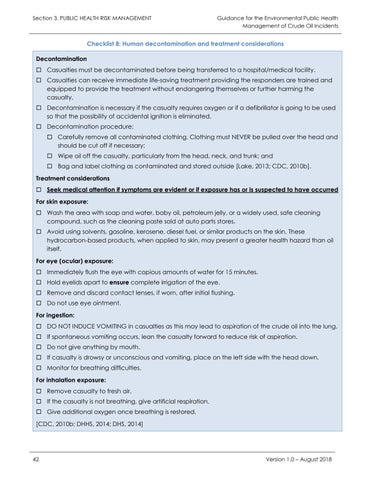Section 3. PUBLIC HEALTH RISK MANAGEMENT
Guidance for the Environmental Public Health Management of Crude Oil Incidents
Checklist 8: Human decontamination and treatment considerations Decontamination Casualties must be decontaminated before being transferred to a hospital/medical facility. Casualties can receive immediate life-saving treatment providing the responders are trained and equipped to provide the treatment without endangering themselves or further harming the casualty. Decontamination is necessary if the casualty requires oxygen or if a defibrillator is going to be used so that the possibility of accidental ignition is eliminated. Decontamination procedure: Carefully remove all contaminated clothing. Clothing must NEVER be pulled over the head and should be cut off if necessary; Wipe oil off the casualty, particularly from the head, neck, and trunk; and Bag and label clothing as contaminated and stored outside [Lake, 2013; CDC, 2010b]. Treatment considerations Seek medical attention if symptoms are evident or if exposure has or is suspected to have occurred For skin exposure: Wash the area with soap and water, baby oil, petroleum jelly, or a widely used, safe cleaning compound, such as the cleaning paste sold at auto parts stores. Avoid using solvents, gasoline, kerosene, diesel fuel, or similar products on the skin. These hydrocarbon-based products, when applied to skin, may present a greater health hazard than oil itself. For eye (ocular) exposure: Immediately flush the eye with copious amounts of water for 15 minutes. Hold eyelids apart to ensure complete irrigation of the eye. Remove and discard contact lenses, if worn, after initial flushing. Do not use eye ointment. For ingestion: DO NOT INDUCE VOMITING in casualties as this may lead to aspiration of the crude oil into the lung. If spontaneous vomiting occurs, lean the casualty forward to reduce risk of aspiration. Do not give anything by mouth. If casualty is drowsy or unconscious and vomiting, place on the left side with the head down. Monitor for breathing difficulties. For inhalation exposure: Remove casualty to fresh air. If the casualty is not breathing, give artificial respiration. Give additional oxygen once breathing is restored. [CDC, 2010b; DHHS, 2014; DHS, 2014]
42
Version 1.0 – August 2018







